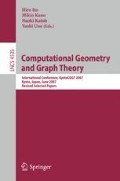Abstract
There is a class of pictures called “pictures of impossible objects”. These pictures generate optical illusion; when we see them, we have impression of solid objects and at the same time we feel that such solids cannot be realized. Although they are called “impossible”, they are not necessarily impossible; some of them can be realized as real solids. This is because a single picture does not convey enough information about depth. Using the same trick, we can also design what may be called “impossible motions”. That is, we can construct a shape of a solid which looks like an ordinary solid but which admits physical motions that look like impossible. A computer-aided method for creating impossible objects and impossible motions is presented with examples.
Access this chapter
Tax calculation will be finalised at checkout
Purchases are for personal use only
Preview
Unable to display preview. Download preview PDF.
References
Anno, M.: Book of ABC. Fukuinkan-Shoten, Tokyo (1974) (in Japanese)
Clowes, M.B.: On seeing things. Artificial Intelligence 2, 79–116 (1971)
Cowan, T.M.: The theory of braids and the analysis of impossible figures. Journal of Mathematical Psychology 11, 190–212 (1974)
Cowan, T.M.: Organizing the properties of impossible figures. Perception 6, 41–56 (1977)
Coxeter, H.S.M., Emmer, M., Penrose, R., Teuber, M.L.: M.C. Escher — Art and Science. North-Holland, Amsterdam (1986)
Draper, S.W.: The Penrose triangle and a family of related figures. Perception 7, 283–296 (1978)
Ernst, B.: The Eye Beguiled. Benedict Taschen Verlag GmbH, Köln (1992)
Escher, M.C.: Evergreen. Benedict Taschen Verlag GmbH, Köln (1993)
Ford Jr., L.R., Fulkerson, D.R.: Flows in Network. Princeton University Press, Princeton (1962)
Gregory, R.L.: The Intelligent Eye, 3rd edn. Weiderfeld and Nicolson, London (1971)
Huffman, D.A.: Impossible objects as nonsense sentences. In: Metzer, B., Michie, D. (eds.) Machine Intelligence, vol. 6, Edinburgh University Press (1971)
Iri, M.: Network Flow Transportation and Scheduling: Theory and Algorithms. Academic Press, New York (1969)
Penrose, L.S., Penrose, R.: Impossible objects — A special type of visual illusion. British Journal of Psychology 49, 31–33 (1958)
Robinson, J.O.: The Psychology of Visual Illusion. Hutchinson, London (1972)
Sugihara, K.: Classification of impossible objects. Perception 11, 65–74 (1982)
Sugihara, K.: Detection of structural inconsistency in systems of equations with degrees of freedom and its applications. Discrete Applied Mathematics 10, 297–312 (1985)
Sugihara, K.: Machine Interpretation of Line Drawings. MIT Press, Cambridge (1986)
Sugihara, K.: Joy of Impossible Objects. Iwanami-Shoten, Tokyo (1997) (in Japanese)
Sugihara, K.: Three-dimensional realization of anomalous pictures—An application of picture interpretation theory to toy design. Pattern Recognition 30(9), 1061–1067 (1997)
Térouanne, E.: On a class of ‘Impossible’ figures: A new language for a new analysis. Journal of Mathematical Psychology 22, 20–47 (1980)
Author information
Authors and Affiliations
Editor information
Editors and Affiliations
Rights and permissions
Copyright information
© 2008 Springer-Verlag Berlin Heidelberg
About this paper
Cite this paper
Sugihara, K. (2008). Computer-Aided Creation of Impossible Objects and Impossible Motions. In: Ito, H., Kano, M., Katoh, N., Uno, Y. (eds) Computational Geometry and Graph Theory. KyotoCGGT 2007. Lecture Notes in Computer Science, vol 4535. Springer, Berlin, Heidelberg. https://doi.org/10.1007/978-3-540-89550-3_22
Download citation
DOI: https://doi.org/10.1007/978-3-540-89550-3_22
Publisher Name: Springer, Berlin, Heidelberg
Print ISBN: 978-3-540-89549-7
Online ISBN: 978-3-540-89550-3
eBook Packages: Computer ScienceComputer Science (R0)

